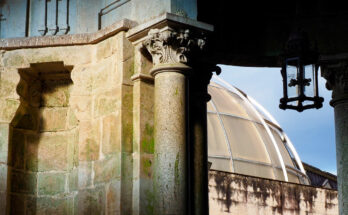Walking along the cliffs of the A Coruña coast, or along the river banks, between trees and mills, or directly along paths that start at the beach… Here we have a few very refreshing routes for the hottest days:
Seixo Branco-Furnas Route (Oleiros). This is one of the three routes that run through the natural monument of the Dexo-Serantes Coast. It is a circular route that covers 3.6 km. To situate ourselves, we have to clarify that Seixo Branco is a peculiar vein of white quartz that can be seen from afar in the cliffs, and serves as a reference for navigators.
The ZEC Costa de Dexo-Serantes is between the Mera lighthouse and the port of Lorbé, between the Ares and Betanzos estuaries, in the Ártabro Gulf. The walk begins in the Canabal area, near the tennis club. It continues towards the old military batteries, installed long ago taking advantage of this strategic point. Along the way we find several furnas, like wells where the sea beats and rises furiously, such as Ollo Pequeno, A Regocha and Ollo Grande. Of course, we can also see the geological vein up close. All this with stupendous views over the Ares and A Coruña estuaries, Cabo Prior and the islet of A Marola. This is an area of great animal wealth, with yellow-legged gulls, crested cormorants, royal swifts… The area’s flora is dominated by large expanses of scrub and gorse.
Costa da Morte Route (Camariñas). This route is refreshing due to the windy air and the fantastic views over the coastline of A Costa da Morte. It is a circular route, in the short distance category, approved by the Galician Mountaineering Federation. The main path is 22.5 km long, although there are two derivations, one to the hermitage of Monte and the other to the Vilán lighthouse. By the way, it can also be done by bicycle or on horseback.

The first section starts from the Sovereign’s castle, the remains of an 18th century fortress, with views of the entrance to the estuary and the coastal towns. It also passes by the Virgen del Monte chapel and goes along the seashore, crossing several beaches, such as Lago and Coidal das Castanas, with rounded pebbles.
The central section goes from the path of Cabo Vilán to Cabo Tosto, also called Trece. It is an area of great scenic, cultural and environmental value. We find the Vilán lighthouse, the interpretation center for maritime signals and shipwrecks of A Costa da Morte, the Vilán de Fóra islet, the Furna dos Infernos, the Armeliña cove, the English cemetery, the virgin beach of Trece and the dune of Monte Branco, one of the highest in Europe.
The final section of the route runs through the inland area where, from above, we can contemplate good views of the estuary and the coast, and it ends in Camariñas, back to the Sovereign’s castle.
Yellow Sisalde (Arteixo). This is the name of one of the paths of the Sisalve River as it passes through Arteixo. The other is red Sisalve, a little longer. The yellow one covers 7 km, and begins and ends at Barrañán beach. At the mouth of the Boedo River, we head towards the Sisalve forest, a good example of an Atlantic forest, with a lot of oak, chestnut, willow, alder, fern… The most significant places on the route are: the Camiño da Area, the Zapata mill, the Barrañán church, Os Boedos, Cartas mountain, the Armentón fort and the Sisalde recreational area. As we see, it is a few kilometers but full of interesting stops.
Verdes Refuge (Coristanco). In the parish of Verdes, we find this fishing reserve, in the Anllóns River ZEC. Here is a small route, only about 500 m, very refreshing, animated by the bustle of the river falls. The path goes along the right bank of the Anllóns river, from the Pose mill to the As Sangueiroas mill. In this section, the rocks appear on the river bed like small islands, between rapids and waterfalls. Some of the mills that appear on the route can be visited, since they have been restored.

The freshness on the journey also has to do with the riverside forest that surrounds us, with a lot of alder, willow, ash, arraclán… There are several wooden bridges to better enjoy the landscape and access the trails on each bank of the river. The refuge also has recreational areas with benches, tables and even grills. From here, we can continue one more kilometer to Ponte Dona, which connects the municipalities of Coristanco and Ponteceso. If we still feel like walking, we can follow the path to Ponteceso, and it would be about 14 km.





